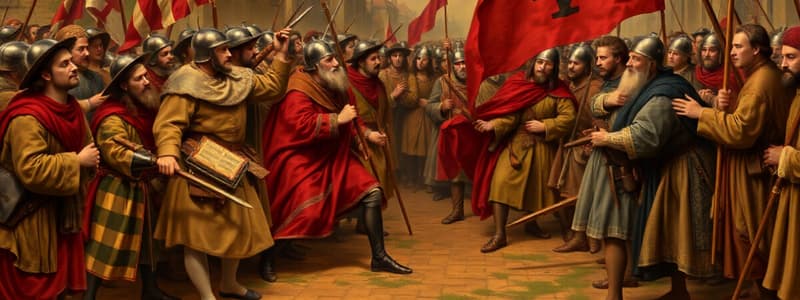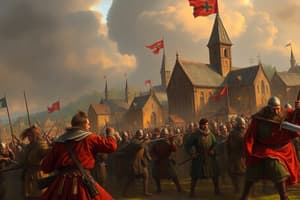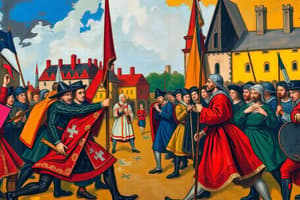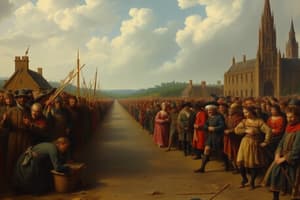Podcast
Questions and Answers
What was one significant outcome of the Thirty Years' War in terms of political structures?
What was one significant outcome of the Thirty Years' War in terms of political structures?
- Empowering absolute monarchies (correct)
- Strengthening of the Holy Roman Empire
- Increased power of the Catholic Church
- Decentralization of power among states
The Thirty Years' War had minimal impact on the economy of Europe.
The Thirty Years' War had minimal impact on the economy of Europe.
False (B)
What concept did the treaties following the Thirty Years' War introduce regarding international relations?
What concept did the treaties following the Thirty Years' War introduce regarding international relations?
state sovereignty
The war accelerated the weakening of ______ and the rise of nation-states.
The war accelerated the weakening of ______ and the rise of nation-states.
Match the following consequences of the Thirty Years' War with their descriptions:
Match the following consequences of the Thirty Years' War with their descriptions:
Which of the following was NOT a cause of the Thirty Years' War?
Which of the following was NOT a cause of the Thirty Years' War?
The Thirty Years' War ended in 1648 with the Peace of Westphalia.
The Thirty Years' War ended in 1648 with the Peace of Westphalia.
Who was the Swedish king that played a significant role in the Thirty Years' War?
Who was the Swedish king that played a significant role in the Thirty Years' War?
The Battle of _____ marked a significant defeat for the Protestants and resulted in the death of Gustavus Adolphus.
The Battle of _____ marked a significant defeat for the Protestants and resulted in the death of Gustavus Adolphus.
Match the following phases of the Thirty Years' War with their key characteristics:
Match the following phases of the Thirty Years' War with their key characteristics:
What principle did the Peace of Westphalia formally recognize?
What principle did the Peace of Westphalia formally recognize?
Albrecht von Wallenstein was a Swedish general during the Thirty Years' War.
Albrecht von Wallenstein was a Swedish general during the Thirty Years' War.
Which battle was a significant Swedish victory during the Thirty Years' War?
Which battle was a significant Swedish victory during the Thirty Years' War?
Flashcards
Political Restructuring
Political Restructuring
The Thirty Years' War dramatically shifted power in Europe, weakening the Holy Roman Empire and strengthening France. This restructuring paved the way for France to become a dominant force in European diplomacy.
International Law and State Sovereignty
International Law and State Sovereignty
The Thirty Years' War introduced the concept of state sovereignty into international relations. It signified a major shift away from the idea of universal religious authority.
The War's Devastation
The War's Devastation
The war caused wide-scale devastation across Europe, resulting in population displacement, economic hardship, and damaged infrastructure.
Weakening Feudalism, Rise of Nation-States
Weakening Feudalism, Rise of Nation-States
Signup and view all the flashcards
Mercantilism and Absolute Monarchies
Mercantilism and Absolute Monarchies
Signup and view all the flashcards
Thirty Years' War
Thirty Years' War
Signup and view all the flashcards
Religious Divisions
Religious Divisions
Signup and view all the flashcards
Habsburg Ambitions
Habsburg Ambitions
Signup and view all the flashcards
Dynastic Rivalries
Dynastic Rivalries
Signup and view all the flashcards
Economic Factors
Economic Factors
Signup and view all the flashcards
Bohemian Phase (1618-1625)
Bohemian Phase (1618-1625)
Signup and view all the flashcards
Danish Phase (1625-1629)
Danish Phase (1625-1629)
Signup and view all the flashcards
Swedish Phase (1630-1635)
Swedish Phase (1630-1635)
Signup and view all the flashcards
Study Notes
Introduction
- The Thirty Years' War (1618-1648) was a major European conflict, driven by religious, political, and dynastic factors.
- Beginning as a conflict between Catholic and Protestant states within the Holy Roman Empire, it evolved into a general European war involving many nations, resulting in significant political and religious restructuring.
Causes
- Religious divisions: The Reformation and Counter-Reformation fostered deep religious tensions between Catholics and Protestants in the Holy Roman Empire.
- Political ambitions: The Habsburg dynasty, ruling the Holy Roman Empire and Spain, aimed to maintain power and control over Europe.
- Dynastic rivalries: Disputes over succession and territorial claims amongst European powers fueled the conflict.
- Economic factors: Competition for trade and resources aggravated tensions among nations.
Stages of the War
- Bohemian phase (1618-1625): The war's outbreak stemmed from a Bohemian Protestant revolt against Habsburg rule.
- Danish phase (1625-1629): The Protestant cause saw Danish intervention, countered by Catholic victories.
- Swedish phase (1630-1635): Swedish intervention, led by King Gustavus Adolphus, significantly altered the balance of military power.
- French phase (1635-1648): France, seeking to diminish Habsburg strength, joined the war, expanding the conflict and greatly repositioning the strategic battlefield.
Key Figures and Events
- Gustavus Adolphus: Swedish king, instrumental in leading formidable and modern armies, achieving considerable successes.
- Albrecht von Wallenstein: Highly effective Imperial general.
- The Edict of Restitution (1629): An attempt to restore Catholic lands and assets, further intensifying religious tensions.
- The Battle of Breitenfeld (1631): A Swedish victory over Imperial forces.
- The Battle of Lützen (1632): A critical defeat for Protestants, marked by the death of Gustavus Adolphus.
Consequences and Outcomes
- The Peace of Westphalia (1648): This treaty series ended the war and reshaped the European map.
- Religious division: The principle of cuius regio, eius religio was formally recognized, granting rulers the right to determine their territories' religion.
- Political restructuring: The treaties altered the European power balance, weakening the Holy Roman Empire and bolstering France.
- International law: The concept of state sovereignty was introduced, marking a seminal moment in international relations.
- The devastation of the war: Widespread destruction, loss of life, and economic hardship affected the war-torn areas, including displacement and infrastructure damage.
Impact on Society
- The war's impact on European society was wide-ranging, affecting religious practice and social structures.
- Weakening of feudalism and rise of nation-states: The war accelerated the transition to more centralized political organizations in several nations.
- Rise of mercantilism and absolute monarchies: The war and its aftermath prompted the emergence of new economic policies and stronger central governing bodies.
- Shifting patterns of trade: Trade routes and economic relationships within Europe and beyond were altered by the war.
Long-Term Significance
- The Thirty Years' War fundamentally shaped the political and religious landscape of early modern Europe.
- It initiated a shift in international relations, influencing the development of modern nation-states and concepts of state sovereignty.
- The war serves as a cautionary tale of the devastating consequences of unresolved religious and political conflicts.
Studying That Suits You
Use AI to generate personalized quizzes and flashcards to suit your learning preferences.




